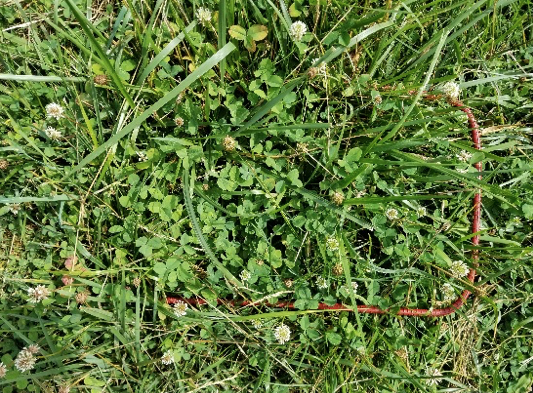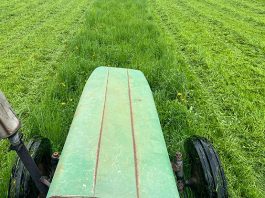It’s August, and I know it’s August without looking at a calendar. The days are getting shorter and it’s state fair time. August is always a busy month for me and I am usually left wondering what happened to it all. I start thinking about assessing pastures, how much forage is present, and how much more forage can be grown between now and dormancy. It’s sad, but winter is already on my mind. Not that I’m looking forward to it, I’m not, but it’s time now to start preparing.
I want to be able to graze as long as possible, so like the games of chess or checkers, you’re better off planning your next move far ahead. I like as much stockpiled forage as possible which means I better be pretty efficient with forages being grazed right now. I always recommend trying to grow as much forage as possible because there are only so many growing days left in the season. The longer you can rest or defer grazing, the more forage that can be grown and stockpiled. Most years, deferment needs to start by mid-August.
Graze, mow or hay the field to even out the stand and hopefully, with moisture, new vegetation will start growing if it isn’t already. If cut for hay, don’t cut too short; cut at least three inches high so it won’t delay regrowth. Apply 30-60 pounds of nitrogen if clover isn’t at least 30% of the stand. Urea works well as long as moisture is present. Judging how much clover is present is misleading. There always appears to be more than there really is. It is best assessed by dry weights…and no, I don’t expect most people to do that.

Defer grazing or stockpile at least one acre of tall fescue per 1000-pound live weight. Yes, I said tall fescue. Tall fescue gets a bad rap most of the time, but it does have one good attribute, it stockpiles better than about any other perennial forage.
Tall fescue’s greatest attribute is its ability to maintain its nutritional value throughout the winter. December, January, and February, tall fescue will still shine; the rest of the time it is only somewhat tolerable. Fall-grown tall fescue can average 13 to 18 percent crude protein depending on how much nitrogen has been applied to the stand and will maintain good nutritional value on up into the spring when new growth starts to appear. I’ve tested lots of stockpiled forage (much of it tall fescue) and the lowest value I’ve ever seen with the fescue was 11 percent crude protein with 62 percent digestibility, and that was in early March right before new growth. At this quality, it is better feed than a lot of hay that is fed. The ergovaline, the endophyte toxin associated with tall fescue, is usually reduced after a hard freeze, so procrastinating on grazing it is a good thing. Always good to test forages and feed to make sure it is meeting the nutritional requirements of the animals utilizing it.
For now, let the fields for stockpiling grow. Continue rotating through the rest of the pastures like normal, maintaining stop grazing heights as much as possible. If you have corn stalks, hay aftermath or annuals that can be grazed, that can provide you more opportunity to defer those stockpiled fields longer and possibly grow even more stockpile.
If grazing corn residues, they are normally best utilized within 60 days of harvest and best allocated out in portions to reduce waste. They are best utilized for spring calving cows due to lack of energy for lactating or growing animals unless winter annuals or brassicas have been added. Corn stalks should be stocked at the rate of 1000 pounds live weight per acre, per 30 days.
Corn stalk fields that are planted to grazeable annuals create even more opportunity to stockpile and buy you more growth time and grazing time. If you have crop fields close that can be grazed, there are a lot of opportunities especially when these are planted to annuals. High quality forage can be produced in the fall if planted early enough. My favorite mix is spring oats, turnips or radish, and cereal rye. The oats and brassica come on early and with sufficient moisture can produce a lot of quality forage. The cereal rye remains fairly quiet in the background until spring and then it kicks in providing the opportunity for some spring grazing or just prime cover to no-till into.

I plan to talk about the grazing of the stockpile in a month or so. It is only August so we’ll first grow it and then we’ll discuss how to serve it to the livestock.
I hope that I’m wrong, but I’m planning on an early fall. I’d rather be prepared and wrong than caught off guard. Early fall is quite often one of the best times to tackle some weed problems, especially biennials, such as bull and musk thistle and burdock. Burdock is a robber of valuable pasture space along with being a bit of a pain to whatever falls prey to its stocky burrs. I find it most often along roads and other areas heavily limed or where heavy applications of gypsum are applied. Thistles, well, they are thistles. They are generally rich in potassium and livestock would probably eat them if not for the spines. These biennials, which mean they produce seed the second year, will first appear as a simple rosette. The rosettes often appear in the fall and are fairly easily killed chemically in this stage. Follow label recommendations on all herbicides and consult with your local extension office if you have questions on what to use or how to best use it. For some plants, but especially burdock and thistles, a slow death is better than a planned quick kill. That reminds me of a tee-shirt I saw a guy wearing recently that read, “Bad choices make good stories.” No, I didn’t ask.
Keep on grazing!
And here are some conferences you might be interested in too!
Grazing for the Future Conference – August 17-18, 2017, Madison, Indiana.
Purdue Forage Management Workshop – September 6, 2017 – Purdue Agronomy Center, West Lafayette. This year will focus more on pasture management. For more information click here.





What kind of seeding rates do you recommend for the oats, radishes and cereal rye? Because we have willow creek winter wheat, spring triticale and purple top turnips in the shop, I would would be substituting.
I look forward to your reply. Thanks
Burdock is a great forage for my mobbed herd. No need to roundup.
You need to distinguish that you are talking about endophyte infected Kentucky 31 tall fescue.
There are great tall fescue varieties available that aren’t toxic.
I don’t think it’s fair that all fescue gets a bad name. The good stuff isgreat all year long!
Comments are closed.